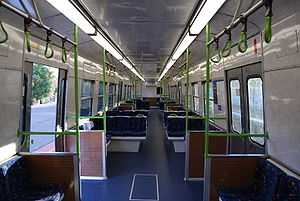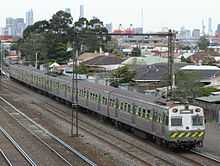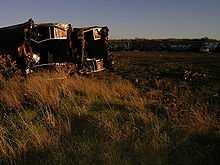Hitachi (Australian train)
- For other trains known as Hitachis, see Hitachi (train).
| Hitachi | |
|---|---|
 Connex refurbished Hitachi at Flinders Street Station | |
 Refurbished Hitachi interior | |
| In service |
1972–September 2008 November 2008–present |
| Manufacturer | Commonwealth Engineering (electrics), Bayswater (bodies), Martin & King Somerton ('M' car fitout), Newport Workshops (fitout and Trailers) |
| Replaced | Swing Door cars, Tait cars |
| Constructed | 1972–1981 |
| Scrapped | 2003–unknown |
| Number built | 118 (3 car sets) |
| Number in service | 14 (3 car sets, permanently marshalled as 6 car sets) |
| Number preserved | 48 (3 car sets) |
| Formation | M-T-T-M D-M, later M-T-M M-T-M |
| Fleet numbers | 273–300 (Motors), 1901–2017 (Trailers), 1–237 (Former Motor Numbers), 301-368 (Former Driving Trailers) |
| Capacity | 536 seated (6 car) |
| Operator | Historically Victorian Railways and successors, MTA, PTC, M>Train and Connex, currently Metro Trains Melbourne |
| Depot(s) | Macaulay Stabling Sidings, Newport Workshops, Craigieburn and Epping (December 2013) |
| Line(s) served | All Melbourne suburban |
| Specifications | |
| Car body construction | Fluted stainless steel |
| Car length | 76 ft 9.5 in (23 406 mm) over couplers |
| Width | 9 ft 9 in (2 972 mm) |
| Height | 12 ft 4 in (3 759 mm), not including pantograph |
| Floor height | 3 ft 11 in (1 194 mm) |
| Articulated sections | Open gangway |
| Maximum speed | 70 mph (113 km/h) |
| Weight | 41 tonnes (40 long tons; 45 short tons) |
| Traction system | 4 x Hitachi HS 834 Springbourne (150 hp or 110 kW) per M car |
| Power output |
600 hp (450 kW) per M car 2 400 hp (1 790 kW) per 6 car set |
| Acceleration | 0.85 m/s2 (2.8 ft/s2) |
| Electric system(s) | 1.5 kV DC Overhead line |
| Current collection method |
Stone-Faiveley ‘V’-type pantograph (original builds) Metropolitan-Vickers 'Diamond'-type pantograph (used as replacements) |
| Coupling system | Janney coupler |
| Track gauge | 1 600 mm (5 ft 3 in) Irish gauge |
Hitachi is the name given for one of a set of electric multiple unit trains that operate on the suburban railway network of Melbourne, Australia. Introduced to service in 1972, the trains are the oldest in the city's suburban fleet still in revenue service. Electrical equipment was supplied by Commonwealth Engineering to designs by Hitachi of Japan, leading to their official name today, though no actual Hitachi-supplied components were used in their construction. Hitachi trains have been also known as Martin & King or Stainless Steel trains officially,[1][2] They are the only suburban trains still in service in Melbourne with no air conditioning, and with windows that can be opened.
Configuration
The single-deck Hitachi trains operate as "M-T-M-M-T-M" sets of six carriages (two coupled sets of three carriages arranged with two motorised carriages on either end of a motorless "trailer" carriage).
Based on a successful trial of longer Harris trailer cars built between 1967 and 1971, the Hitachi train used carriages 75 ft (22.86 m) long, up from the standard 59 ft (17.98 m) length of the earlier suburban cars.[3] The revised carriage design enabled a six car Hitachi train to seat 560 passengers, up from 540 for a seven car Harris train. Maximum load for a Hitachi was 1 500 passengers, 300 more than a Harris.[2]
As delivered, Hitachi trains were composed of three types of carriage, M (motor carriages including a driver's cabin at one end), T (trailer carriages with no motors), and D (a trailer carriage with a small driver's cabin). These cars were arranged in sets of M-T-T-M and M-D, which could be arranged together to create a six car set. All but one of the #68 D carriages produced were later converted into T carriages. (The exception being D #353 was involved in a collision at Pakenham, that also resulted in the scrapping of Guard's Van Z 286) The first M and D carriages delivered were provided with nose doors at the front of the cab. These were later removed from the early carriages, and the feature was omitted from later sets.
The previous carriage configurations were replaced by the current symmetrical three- and six-carriage setup by the late 1970s for the opening of the City Loop. A total of 355 carriages were built, although one of these was to replace a carriage written off in an accident while the fleet was still being delivered.

Service



Intended to replace the first generation of electric trains, the Swing Door and Tait trains, the stainless steel Hitachi trains were the first Melbourne suburban trains to feature heated carriages and power-closing doors[3] (operated by the guard, opened by the passengers by hand). The M and D carriages were built by Martin & King, and the T carriages by the Victorian Railways.
The first Hitachi train to operate in revenue service was the four-carriage set #1M-#901T-#902T-#2M, on the St Kilda line (now converted to light rail), on 24 December 1972. The 237 motor carriages that have been in service have been numbered #1M through #237M, and the 117 trailer carriages, #1901T through #2017T. On 15 August 2009, the remaining Hitachi carriages were renumbered in order to make way for the second order of X'Trapolis trains, which would also start from #1. The remaining M cars were renumbered from 273M up to 300M, however the new numbering does not reflect the age of each car. The numbering reflects which T car is in each set, the lowest numbered T car receives the lowest numbered M cars, in order of which M car was already the lowest (for example, #2007T was the highest-numbered T car, so #23M was renumbered 299M as it was lower than #233M, which was renumbered #300M).
Carriages originally ran in a plain stainless silver livery, receiving green and gold side stripe with the introduction of the Metropolitan Transit Authority, the side logos being altered with the re-branding as The Met. The side logos were again altered with the introduction of Hillside Trains and Bayside Trains, with the latter also applying branding to the front.[4] When the carriages were refurbished under Connex, the green and gold livery was removed, restoring the carriages to their original 'silver' colour, with the addition of Connex blue and gold striping on the lower section of the leading cars, and two blue and gold panels behind the driver's cab. The seats in the passenger area also received new fabric, similar to that of an Alstom-refurbished Comeng. With the introduction of Metro, the Connex logos have been covered up with Metro stickers. It is uncertain if these trains will receive a new Metro livery or remain in their 'silver' form. Because these trains are not flat-sided, this makes it difficult to create an all-over sticker based livery, as shown on Comeng trains where only the flat sections have been stickered.
During the mid-1990s, over half of the Hitachi M cars received cab upgrades, with improved air-conditioning in the driver's cab and double-thickness windscreens with aluminium replacing the original rubber surrounds. After these upgrades were made, the non-upgraded M cars were no longer allowed to lead a train in revenue service, effectively making them B units. Another minor refurbishment was made to the interior, replacing the woodgrain upper panels and bone-coloured roof with off-white panels. In addition to the panel replacement, luggage racks and advertising boards were removed and seat bases were repainted to match the off-white walls. Two M cars have since been preserved in their original unmodified form, while a third M car (#187M) as modified by the PTC is on static display at the AHRS Museum in Williamstown. In 2008, the remaining seven 6-car trains were again modified, mainly with a more powerful driver's air-conditioning system replacing the twin white 'pancake' vents on the roof, however three other 'leading' cars (#9M, #89M and #225M, now #277M, #281M and #296M respectively) were left without the 2008 modifications and relegated to being in the centre of the trains indefinitely.
Retirement and refurbishment

New X'Trapolis and Siemens train have been progressively introduced since 2002 to replace the ageing Hitachi fleet, which has been largely withdrawn from service.[5] The X'Trapolis and Siemens trains have features such as push button operated doors and air conditioning, the lack of the latter feature making the Hitachis unpopular with Melbourne commuters.[6]
The final six 6-carriage trains were to be withdrawn after the 2006 Commonwealth Games,[7] but instead received a minor refurbishment and are being retained until a date that is yet to be confirmed, due to a high increase in patronage. Withdrawn carriages have either been scrapped, sold to private buyers across Australia, stored, or acquired by railway museums and preservation groups.
A report in February 2007[8] (by which time 31 trains in the Siemens fleet were out of service due to safety concerns) said the Victorian Government was negotiating to lease one 6-carriage set from Elecrail, a rail preservation group and repurchase another 3 carriages from a private seller to supplement the fleet. An additional three 3-car Hitachi trains were purchased back from Australian businessman Mr Horne, by the Victorian government in April 2007 to provide spare parts for the fleet. The Elecrail set re-entered service in December 2007.[9]
Cab air conditioning has since been rolled out to the remaining fleet. In late 2007, Hitachi set #37M-#1979T-#36M - #110M-#1910T-#42M was modified to meet driver union requirements and also re-stickered into Connex livery. All remaining sets have since received the same treatment, as well as a refurbished interior.
In September 2008 Public Transport Safety Victoria withdrew the remaining trains from service due to concerns over corrosion around the doors and floor. A series of tests will be carried out before the trains are sent to the Ballarat North Workshops for repair work.[10] It was decided to proceed with the repairs as the trains are required under a new timetable introduced in November 2008. The repair work is expected to cost $2 million.[11]
As of December 2013, the future of the Hitachi remains uncertain - of the seven remaining six-car sets in service, three are presently stored at the Macaulay Light Repair Centre in sidings that are subject to an Occupational Health and Safety ban,[12] two are stored at Newport Workshops, and one each at the Craigieburn and Epping maintenance facilities. Metro have indicated that their use over Summer 2013 will be avoided wherever possible due to their lack of air-conditioning.[13]
References
- ↑ Peter J Vincent - "M - Hitachi/M&K Suburban Motor"
- ↑ 2.0 2.1 VicRail Public Relations (1981). Power Parade. ISBN 0-7241-3323-2.
- ↑ 3.0 3.1 Lee, Robert (2007). The Railways of Victoria 1854–2004. Melbourne University Publishing Ltd. p. 186. ISBN 978-0-522-85134-2.
- ↑ "Prayer is asking for a Hitachi, faith is carrying the camera - Railpage Australia Forums (Melbourne suburban)". www.railpage.com.au. Retrieved 2008-06-23.
- ↑ "Media Release: X’TRAPOLIS WELCOMED TO MELBOURNE’S RAILWAYS". www.dpc.vic.gov.au. Retrieved 2008-03-14.
- ↑ Moynihan, Stephen (23 April 2007). "Minister defends train buyback". theage.com.au. Retrieved 2007-06-21.
- ↑ "Media Release: NEW SIEMENS TRAIN HITS THE TRACKS". www.dpc.vic.gov.au. 6 December 2005. Retrieved 2008-03-16.
- ↑ A Dad's Army of shunted carriages called up in crisis, The Age 4 February 2007
- ↑ "VICSIG - Suburban Trains". www.vicsig.net. Retrieved 2008-03-14.
- ↑ Clay Lucas (5 September 2008). "Commuter overcrowding, but silver Hitachi trains taken out of Melbourne's rail system". The Age. theage.com.au. Retrieved 2008-09-05.
- ↑ Clay Lucas (3 November 2008). "$2m to get city's oldest trains on track". The Age. theage.com.au. Retrieved 2008-11-13.
- ↑ Internal Metro Documentation
- ↑ Deborah Gough (2 December 2013). "Melbourne train services reduced over summer in major works upgrade". The Age. theage.com.au. Retrieved 2013-12-06.
| ||||||||||||||||||||||||||||||||||||||||||||||||||